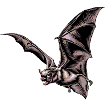Museum, University of Nebraska State

University of Nebraska State Museum: Mammalogy Papers
Document Type
Article
Date of this Version
December 1997
Abstract
Casts of upper canine teeth of 15 species of microchiropteran bats were fixed securely into a testing machine and made to puncture the bloom side of an apple. The force necessary to break through the surface of the apple was regressed against both shape of the tip of the canine and the size of the animal. Sharper tips require less force to puncture than blunt ones. Results were also verified using giant two-dimensional models of Plexiglas™ with sharp and blunt tips that were loaded onto a Plexiglas™ beam. Fringes, or stress lines, are more highly concentrated at the point of contact for a smaller radius than for a larger radius under the same loading conditions, indicating that stress in the beam is higher and more concentrated at the sharper tip. Ours is some of the first experimental work to quantify apical sharpness of a tooth and performance as it punctures a substance.


Comments
Published in Life Among the Muses: Papers in Honor of J. S. Findley (T.L. Yates, W.L. Gannon, and D.E. Wilson, eds.). Special Publication 3, Museum of Southwestern Biology, Albuquerque, NM. Pp. 151-157. Copyright 1997 Museum of Southwestern Biology. Used by permission. http://www.msb.unm.edu/